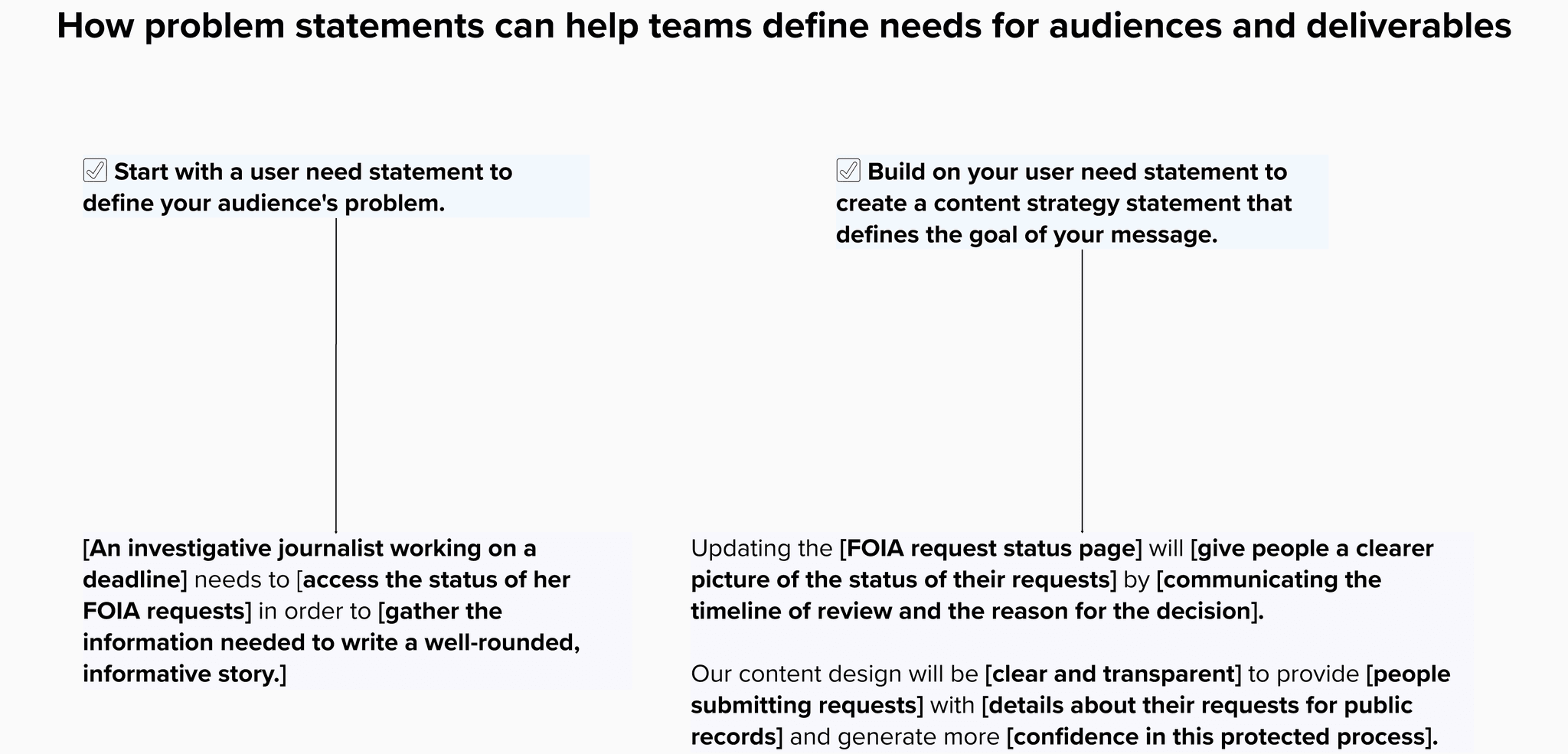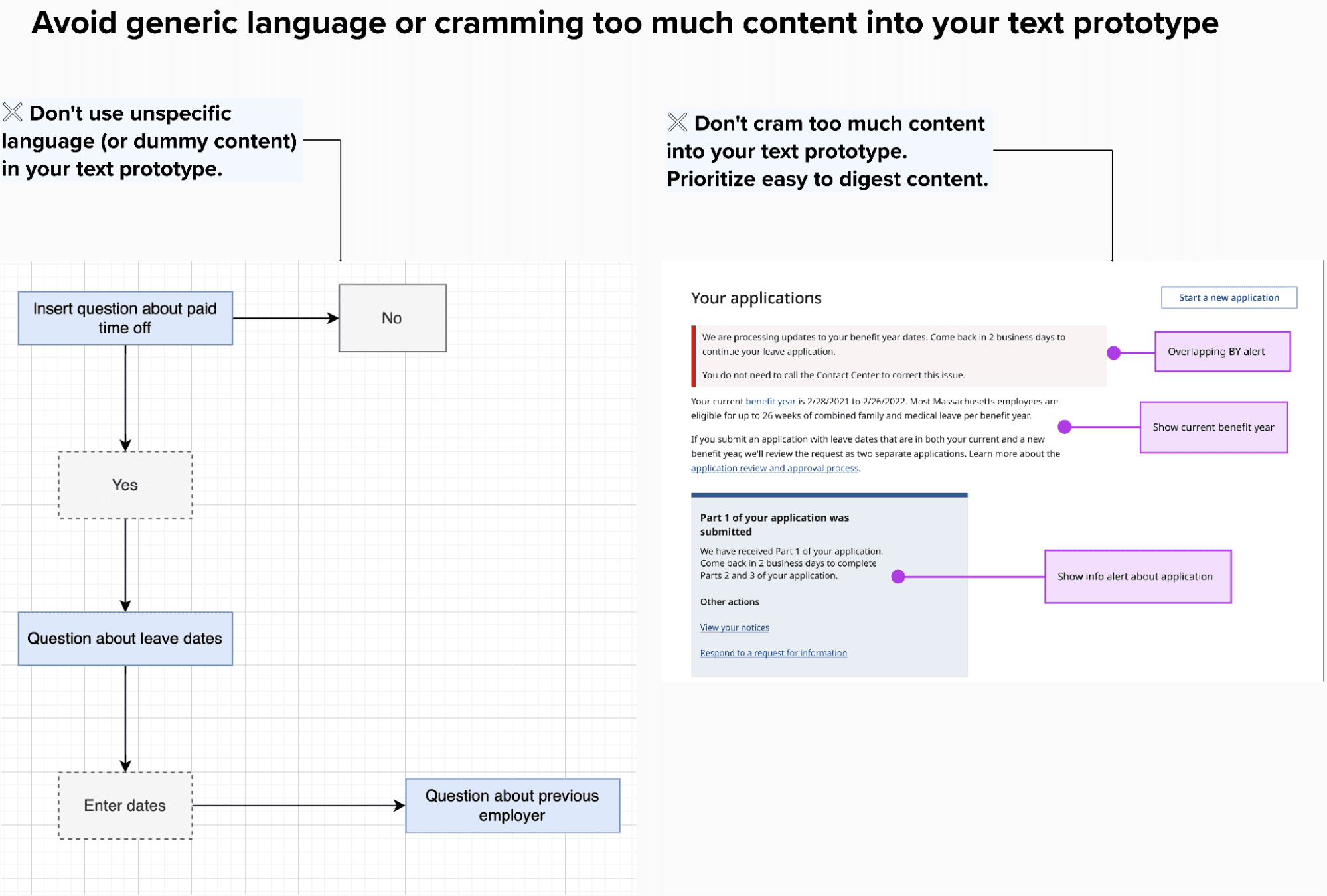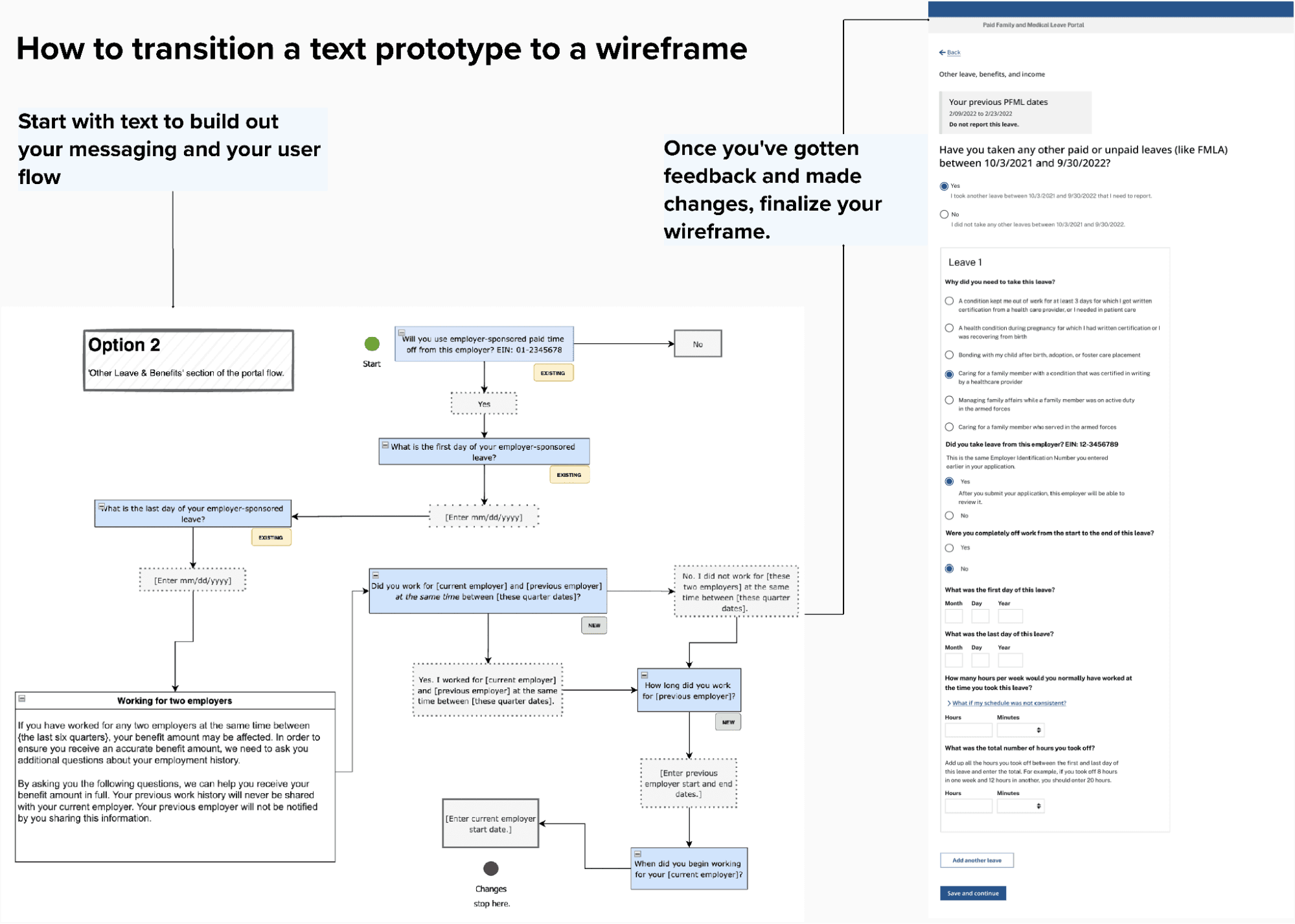Digital government services serve as a conversation between people and policymakers. Content design is the bridge between these two parties, creating and supporting the needs of the public through the technology we create and support. Our design process at Nava employs a content-first design approach because what people see on their screens depends on easy-to-understand content.
If we neglect to consider content first, we risk creating a product that does not meet a person’s needs. But if you take time to consider content design prior to or alongside designing your product, you reinforce a purposeful experience for people while also enabling people to actively decide to adopt your government product or service.
In this toolkit, we will uncover what a content-first design approach looks like in practice and determine when it’s most appropriate to apply to your design processes. This toolkit is the first in a series of two that cover content-first design. If you want to learn how to fit a content-first design approach into your agile software development process, check out the second toolkit.
This toolkit can help you
- Learn what content-first design is
- Build your understanding of content-first design practices
- Develop a human-centered content strategy
- Prioritize a content-first design process
Helpful definitions
Content strategy is the practice of planning for and managing human-centered content.
Content design is the practice of designing human-centered content.
Content-first design is a design approach where both your content strategy and content design determine your service's user interface.
Human-centered content is content that supports people’s goals and actions within a product or service. It is relevant and sensitive to your audience’s needs and circumstances while remaining plain and accessible.
A content audit is the process of analyzing and reviewing all of the content in your product or service. This could include text, images, videos, calendars, infographics, and other elements.
A user need statement is a clear way of communicating to your team and government partners about who your audience is and what they need from your product or service.
A content strategy statement defines what your content needs to say or do to help your audience navigate your product or service with ease.
Pair design is the practice of having two designers work together on each aspect of a design project.
What is content-first design?
Content-first design is a design approach where your content strategy and content design determine your service's user interface. The goal of content-first design is to create straightforward messaging. Straightforward messaging can include text, charts, diagrams, graphics, videos, calendars, and other visual or textual representations used to communicate a clear message to people. When designing public services, we want to focus on human-centered content before anything else, which means designing content that prioritizes people’s lived experiences. Applying a content-first design approach to your product or service puts your team in the best position to deliver human-centered content that solves your audience’s specific needs.

In content-first design, we aim to value people’s needs by focusing on:
Why we need to say something, and
How to communicate our message plainly to our audience.
The “why” of your content determines whether your product's message will be useful for your audience. This approach will help you analyze the intent behind your content and examine “how” your product or service can effectively communicate your message to people. It also allows you to uncover constraints or gaps in your messaging and protect the user experience.
You can measure the success of your design by how well your audience understands your content and how they take action based upon it. Content-first design supports meaningful site interactions, giving your audience clarity as they navigate your product or service. It will also help your content strategists discover what your audience wants from your service and enhance your team’s design processes.
Exploring content-first design methods
When we apply a content-first design approach to public services, we start thinking about content strategy at the beginning of the project. Our content-first approach is prioritized within our design framework and includes the following methods.
Ask questions
Prioritize open conversation with your collaborators and subject matter experts early on in your process.
Questions you can ask include:
How will this content help people move easily within our product?
What actions do we want people to take? What outcomes are we aiming for?
How do we want people to feel when interacting with our content?
What reading level does our audience need to navigate our product or service with success?
When and under what circumstances or conditions might people be consuming this content?
What is the key message we want our content to communicate? How can we plainly communicate our message?
Each contributor on your delivery team may have a different perspective on the problem you’re solving for your audience. Value each perspective on your team equally. Your goal is to understand the complexities of the problem before you begin building toward a solution.
Human-centered content should establish trust and be easy to digest. The more you know and understand your audience, the more you will know and understand what they need. Avoid guessing or assuming what people need and ask them through research and discovery. Conducting user research will help you explore what people need and how their needs compare to what stakeholders want.
Questions help you discover what words you need to say when communicating your message. They will also equip you with the information necessary to develop a human-first content strategy and provide robust recommendations to stakeholders.
Gather content and create a site map
Examining existing content and mapping out how it sits within your product can be part of your content auditing phase. Content audits help you determine what content you have and what content you may need. Audits also allow you to plan your content strategy and prioritize necessary changes to existing content. Regularly auditing your content supports a streamlined content design process and provides you with a fuller picture, giving your team something to anchor your future design recommendations in. Mapping your content will help you outline your audience’s journey through your product or service, giving you a clear picture of how people may be experiencing your platform. Once you audit your content and map out the content flow, you’ll be able to formulate areas of improvement.
When you are able, develop artifacts with:
Content governance: Content governance determines who owns, creates, and approves your content.
Consistency: Unifying content across your product can ensure that the content on the backend matches the content on the frontend and that terms mean the same thing across both.
Guidance: Creating new or utilizing existing style guides, voice and tone guidance, editorial guidelines, and any other general instruction or direction. A style guide is a guide for how you plan to communicate with users. Understanding your voice and tone will help you create consistent messaging with a singular voice, even when the tone (or urgency) of your content changes. Once you’ve developed these materials, you won’t have to do so again. You may also be able to leverage another organization's existing style guides if it aligns with your mission and project deliverables. Whatever you decide, it’s good to refer back to these guides often when starting a new project and auditing these guides whenever your product or service changes dramatically.
Information architecture: Similar to a service blueprint, information architecture organizes the content within your product by providing an operational map showing how your content functions for users.
These types of artifacts will make it easier to reflect on your product’s content needs as you iterate your content design.
Workshop your content
Content-first design is a team effort. Leading workshops with your team to help them understand the value of a content-first process will help your team adopt this process. Take a look at this workshop template we made to introduce content-first thinking to our design teams. Our Massachusetts Paid Family and Medical Leave design and research team has been slowly adopting an integrated approach to content-first design, embedding it into our longstanding, existing processes and using it to build upon our fundamental design principles. When we began to ramp up content-first thinking on our team, we used this template to conduct a workshop around content-first design methodology.
This workshop aligned our team around a few common goals, including:
Consistently communicating reading level scores for content to our teams and government partners
Checking in at the start of a new epic to ensure our teams are incorporating a content-first approach into our work
Exploring new or different ways to make content easy to digest
Including teams and government partners early on in the process
Defining problems
In content-first design thinking, it is important to align on defining your problem before building potential solutions. A user need statement defines your problem, while a content strategy statement creates alignment around your intended message.
A user need statement is a practical way of thinking about what you want your content to achieve for your audience. You can use it to summarize who your audience is, what they need, and why what they need is necessary for your particular audience. You can rely on this statement throughout your strategy and design process and use it as a measure of success throughout your development and implementation processes.
Here is an example structure of what a user need statement could look like:
[Specific audience] needs [what do they need?] in order to [achieve this goal].

Developing an accompanying content strategy statement helps you build upon your user need statement. A content strategy statement defines what your content needs to say to support people. This will set guardrails for your implementation team by establishing an agreement on what message you want to communicate to your audience before you begin drafting your message.
Here is an example structure of what a content strategy statement could look like:
Updating the [specific product or feature] will [goal] by [action]. Our content design will be [adjective] to provide [specific audience] with [noun].
Prioritize your content
Deciding what you need to say to people (and when you need to say it) impacts your messaging. Prioritize your information using a prioritization grid to better understand what you must communicate to your users. Take a look at this workshop template we made to prioritize information on one of our state projects. You’ll want to determine what you definitely need to say, what you probably need to say, and what you might need to say.
You definitely need to say something if your audience needs it to easily and plainly interact with your product or service.
You probably need to say something if it will add bonus value for your audience when interacting with your product or service.
You might need to say something if your audience or government partners expect to see it reflected in your product or service.
Content prioritization is all about discovering the core of your message and helping your team to maintain a content-first design process from beginning to end.
Prototype with words
Once you’ve completed your content strategy, you’re ready to start designing your user interface. Prototyping with words is a preparatory phase where you use text to imagine a user interface that supports your intended messaging. This should be an early phase prototype that includes a simple text file that will later transition into a wireframe. Text prototyping is best done collaboratively with a designer and a content strategist.
Start with your user need statement and build out a text prototype that is informed by your previously developed content strategy and content prioritization grid. Use your text prototype to build out your wireframe. A wireframe is a structural layout for your product’s content and functionality that reflects the messaging you aim to launch. Because this approach is content-first, your user interface can serve as a tool to help you iterate and solidify your content strategy; a wireframe does not have to be a definitive construct for your content to fit into.
Avoid using dummy content. When you use dummy content, you run the risk of squeezing content into a predetermined user interface. You can think of it like putting on a pair of shoes that are half a size too small. Your feet become uncomfortable and constrained. When you put on shoes that compliment your specific size, it’s comfortable. You’re able to move about easily. In the same way, allow your wireframe to communicate your content design from the beginning, even if it’s just a draft.
Don’t do this:

Do this:

Content-first doesn’t mean you need to get your content finalized and approved before developing your user interface. It’s important to work with your fellow designers to build a content design and a user interface simultaneously.
You should begin building your user interface when:
You feel the content strategy is in a good place.
You need a user interface to move the content strategy forward.
You’re stuck because the language requires a subject matter expert eg. a lawyer to move forward.
Your content strategy is blocked by engineering logic, product timing, and/or UI changes. If you find your content strategy is stalled by other factors, you may need to shift focus to your UI and come back to your content once you are unblocked.
Cross-disciplinary teammates may have difficulty conceptualizing the product needs solely through a content strategy.
Work collaboratively
You can use pair design to develop your wireframe collaboratively. Pair design is the practice of having two people work together on each aspect of a design project in the same room (or online meeting). This is central to the practice because it improves communication between the two parties and reduces the communication overhead, allowing for higher-quality design with less unnecessary documentation. By working in pairs and sharing context on a product, designer/researchers and content strategists can develop a content-first practice while building a strong design culture on your agile team.
Set standards
Your content should be:
Plain and simple
Clear
Tailored to your audience
Explore alternative approaches
You don’t have to use words. Content-first design is about effective communication, and, sometimes, text isn’t the most effective tool. If a person needs to know when their appointment is, show them a calendar. If they need to book an appointment, create an appointment booking tool. Taking this approach will allow a wider audience to easily understand your content, giving people clarity about what actions they can and should take.
Get feedback
Ask for feedback from subject matter experts, government product owners, and stakeholders about your content design early and often. Stakeholders should always understand the impact your content design will have on your audience. The intent of your content is important. Not everyone will hold the same context as you, especially if your stakeholders have been focusing on multiple features at once while you’ve been placing your focus on one feature. Other stakeholders might have deep institutional knowledge that you can surface and utilize. Acknowledge that your government partners can provide a new or more nuanced context for seeing the work, and don’t be afraid to collaborate with them toward a solution.
When sharing your wireframe with stakeholders, remind them of what steps you've taken up to this point to help them build context. Be clear about the purpose of the content, your team’s intent, and your audience's needs. If able, get feedback from as many people as you can as often as you can, especially from your audience. Content-first thinking requires us to think about people first. The best way to know what people need is by asking them!
Feedback can include:
Walking stakeholders through your content design in-person (or in an online meeting) for immediate responses and reactions
Sharing your content design with subject matter experts asynchronously and asking them to comment directly in your document
Hallway testing, or asking your colleagues to look at your designs, particularly those who have not seen them before
Usability testing, or sharing your prototypes with your audience in person (or online meeting) for immediate feedback
Implement together
Ideally, your project team has been alongside you throughout the entire design process. The effectiveness of a content-first design approach only increases when you begin to include interdisciplinary perspectives such as engineers, product managers, and technical delivery managers. When everyone can unify around a message and how to implement it, teams are able to create human-centered public services, end to end. Learn about how to fit a content-first design process within your agile team.
Get in touch
If you use this guide, we’d love to hear from you. To share questions or feedback, email us at hello@navapbc.com.
Special thanks to Lisa Spitz, Sarah Frazier, and Evette Williams for contributing to this toolkit.
Written by

Content designer


